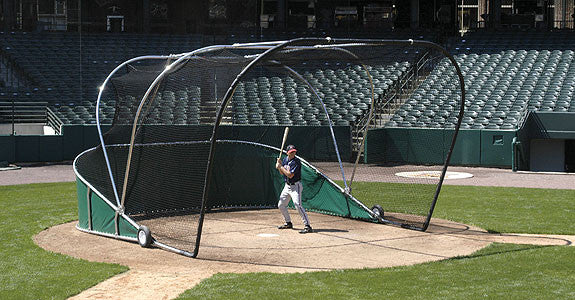Hi Coach,
Coaching up here in Northern California, Little League (10-12 year olds, Majors). The one thing I have the biggest problem with is kids pulling their heads as they swing and not keeping their eyes on the ball. I've tried a lot of home remedies, but nothing works consistently. Any hints?
Thanks,
Don:
=================================================
You are correct this is a problem and you're correct until he can once to stay in and look at the ball while he swings it will not happen.
The first and foremost thing is that they have to get in the right sequence: have to step and get their foot on the ground, rotate their hips,then bring the bat through the strike zone hands first.
The best drill that I've found for this is a version of the soft toss drill. Get a screen (probably a pitcher L-screen) and have the batter stand at the plate (preferably in a cage) and soft toss directly at him both underhand and overhand just like your throwing pitches over the plate, using a screen to protect yourself. This will allow him to concentrate on the three steps and not worry about how hard he's going to hit it or if he's going to get it and he can keep his head down and see the ball all the way and even trying to see it come off the bat.
Hope this helps and if we can help you more with getting DVDs or conversation please just let me know.
Coach Arnald Swift
Dear Coach
My son has played baseball for several years. As he gets older his hitting does not seem to be improving. I take him to the batting cages and he does very well. He is currently on his high school team and does well at practice. When he gets up to the plate, it seems like he freezes. He either walks or strikes out both swinging and looking. His first scrimmage game he got 2 hits. When the real games start he seems to struggle. As a result he has not been starting the games and only goes in as a sub which I think puts more pressure on him. He has talked to his coach about getting more playing time to help him get more up at bats and basically the coach told him that he could not promise anything and that he needed to just get up there and do his job when asked to. I think his struggling is fear of disappointment, to us and his coach. How can I help him get over this fear or to gain more confidence in himself?
Marc
========================================
Dear Marc
Let's make sure of one thing first off the bat does he have good mechanical skills and does he batting practice pitching, tee work, soft toss work well and consistently. My guess is you're going to answer yes then I have to agree 100% that it's all mental. What your boys doing is he thinking way too much and not just seeing the ball and hitting it. I don't know if you have control on are not but if I was his coach and I saw these things I would start to correct it by telling him that he has to hit the next pitch no matter what and if there are runners on base and we can collect hit-and-run, but in reality what were trying to do is take the decision-making out of his hands and make him swing at the next pitch the matter where it is. You will actually need to do this for an entire game and yes he may swing at some bad pitches anyway make an easy out or two but he will swing the bat he will make contact I promise you that. It's a very odd thing when you take away the decision-making, batter that actually is pretty decent they almost always get the ball the matter where it is in the strike zone out of the strike zone it doesn't make a difference they will make contact because their swing is good and they're not deciding if I should or shouldn't swing they know that already so they're just trying to get the ball and they will. Now if you can't do that a game because you don't have the control and what you need to do is go in the cage and tell him swing of this one no matter what don't swing at this one no matter what and start to take away the decision-making. You're just trying to get him comfortable with looking at the ball coming at him and swinging at it not whether it's a ball or strike not whether it's a curve or fastball just see the ball and hit. You will be amazed at how effective that is.
thoughts on breaking pitches, when should players start opinions, age breaking pitches are appropriate, general thoughts on age and breaking pitches
Coach
I would also like to inquire on what team he should be trying out for next year. He has
excelled well in middle school baseball, and his
coaches advise him to start off at Junior Varsity and then play at the varsity level for the next 3 years.Is it a good idea to skip freshman for J.V. and play for 3 years on varsity, even though he has the capabilities and determination? Whats your advice?
thanks for the help, I would really appreciate it.
=====================================
The common denominator here is that no matter what level he plays or any age he has to play, I have seen good players skip a level and then have to sit on the bench at the level they are trying to play because they were too good for the level below but they were quite good enough for the level they are suiting up for. This would be true in any sport. I personally would rather have a kid play at a lower level and be a player and get a lot of time than to be a level up (which kids find prestigious sometimes) but not get a near enough time. My answer keep him at the level he can start at.
I would add one more thing here, as a teacher and a coach for 34 years I find parents put too much value on a players performance in the athletic arena and not enough in the academics. Don't get me wrong I spent thousands of dollars of my kids athletic career and they got college scholarships but that's where it stopped as will happen with almost every single kid. With the exception of very rare individuals we should be going to school for its educational benefits and playing sports, not the other way around going to play sports and try to get education just because it's there. As good as your boy is the odds of him doing anything more than getting help with his education are rare, in fact it's my belief that if he has enough talent to make a living playing sports, then they will find him no matter what.
Thank you for your interest and hope we can help you sometime. And these are my thoughts and comments is nothing written in stone you and I are just having a conversation, mine just comes from a different perspective.
Coach Arnald Swift.
My son is 5-1/2 and will be playing t-ball this spring.
I am wanting to practice playing throw and catch with him.
What is the best way to teach him how to catch with his glove.
It seems hard for him to manipulate his glove... that is to get it to open and close, and the coordination of catching it with the glove. Maybe I'm expecting too much at this young age? Should I just encourage him to throw to me, and let me toss it back?
Thanks,
John MacKinnon, Santa Maria, CA and Michelle
____________________________
Thank you for the question it is a good one and most parents/coaches don't even think about it.
There are a couple of things that you need to remember when catching a ball. The first and foremost is that your fingers must be pointed toward the ground if the ball is below your waist, and your fingers must be pointed up to the sky if the ball is above your waist. This has to happen and you will find very quickly that he wants to have his fingers pointed downward all the time regardless of how high or where the ball is.
What I recommended what I do with real young kids learning to: play catch, roll the ball to them, throw underhand flies ( not very high just a little bit over their head) with a tennis ball. Then believe it or not the most important thing of all is to take the glove away from them. It is a very interesting phenomenon without the glove he will automatically have his fingers and hands in the right position. Please play catch with him without the glove for at least three or four weeks straight. I consider playing catch with him putting the ball on the ground, straight at him and up in the air.
After you've done this for awhile and he is catching the ball with his fingers in the correct position even if he drops the ball a lot don't worry. Now get him a small cheap glove at Wal-Mart or someplace, one of the biggest mistakes we make is a glove is too big and too stiff and when he starts learning he needs just a small limber glove.
Thank you for your question and I certainly hope you and your boy have fun being out in the yard and learning to catch the ball because it's great time together and certainly an important baseball skill. But you're also creating a good athletic skill as well as the time spent. Please do not get too frustrated with him as this is not an easy hand eye coordination skill to learn but it will come. Don't forget take the glove away from you learn to catch with your hands.
Best of luck
Coach Arnald Swift
how do we get the boys ready to play or practice. Frame of mind, Before, drills, attitude, organization,
George writes and asks:
I was wondering how old I should be before I start throwing breaking balls.
===============================================
George
I personal feeling on this are held by most good coach's that have seen a lot of kids pitch.
We would like to see you hold off until puberty, so that bone growth and muscle development are starting to be there.
This is not to say there are not things any kid pitching can't do to be effective. The first and foremost is to change the grip. EX: 1 finger-1 seam fastball, 2 seam fastball, 4 seam fastball, most important change up using 3 fingers, 4 fingers all with the same arm action as that of a fast ball.
And as I have mentioned before learn to pitch to spots and situations. To be a pitcher we have to be able to throw strike's if we can't do that then you can't pitch no matter what type pitch or how hard you throw.
Coach Arnald Swift
=============
Would like too know you opinion on this answer/subject.
George & Lucy (ask)
I was wondering how old I should be before I start throwing breaking balls.George
I personal feeling on this are held by most good coach's that have seen a lot of kids pitch.
Coach Swifts answer
We would like to see you hold off until puberty, so that bone growth and muscle development are starting to be there.
This is not to say there are not things any kid pitching can't do to be effective. The first and foremost is to change the grip. EX: 1 finger-1 seam fastball, 2 seam fastball, 4 seam fastball, most important change up using 3 fingers, 4 fingers all with the same arm action as that of a fast ball.
And as I have mentioned before learn to pitch to spots and situations. To be a pitcher we have to be able to throw strike's if we can't do that then you can't pitch no matter what type pitch or how hard you throw.
Coach Arnald Swift
Parents, as your boy or girl gets better and progresses into the sport of baseball and/or softball they're going to be faced with tryouts. Where a coach or set of coaches trying to determine if he or she can play on their team regardless of whether it's elite travel or just regular league many times were faced with the try out. If the tryouts are well-run you should be able to see comparisons between your player and the other players and how they can hit, run, throw, field, and at times how well they understand the game through situations.
All tryouts try to create measurable's so that they can validate their choices both to themselves and the parents. Many times parents don't see, in fact most always, their child/player in the same light as the coaches that are doing the evaluation. By measurable's we mean something that the player can do that we can physically and mathematically major.
Typically these are: running speed how fast over the distance from home plate to second base, arm speed how fast does he throw the ball from the pitcher's mound and from the shortstop position to first base -- this is measured with radar almost always. On the batting aspects New technology is allowing for a measurable on the bat speed, bat angle, exit speed of the ball off the bat all these things are done using a machine or a batting T so that little or no difference between one boy/girl to the other.. Something we always try to avoid is the human element in a tryout,
you should note as a parent or try out administrator that there needs to be opinion place for somebody that knows the game and knows athletes to be able to comment on athletic ability, quickness, correctness of throwing motion, correctness of hitting technique,, awareness of the situations when placed into the field or at the bat and a situation is simulated.
But that human element does enter into when we determine if the player has a good attitude, hustle, pays attention, will be a good team player and that the parents and the player understood what they're trying out for and most the time with the costs going to be both in time and in money.
All these are things that you as a parent and as a coach trying out need to consider, this article is a long ways from inclusive but I would hope it gives you some thoughts of what you're going to be faced with or what you have to do in tryouts.
Coach Arnald Swift
Baseball tip Some Coaches Notes On Baserunning
I wish I knew why so little time is spent on baserunning in practice.
Maybe there’s just so much to do coaches are less comfortable with their knowledge, and as I said, I don’t know.
But what if it were true that you could actually steal a few extra victories in a season? Would you feel it was important enough to rethink it? I hope, yes. But where would you start...and how would you implement it?
Some quick thoughts:
Decide how much time you would dedicate, then DO IT. Now they can get better, quicker and it becomes a habit for the entire team.,Explain to the team about a new weapon they will be using: baserunning! Let players know that all players can help, not just Johnny Fast-Guy. Be prepared for your 2nd practice drills to go 20-30% better than the 1st! Be prepared to get excited (as will your players) as this happens.
Make it a part of your practice routine. You’ll even come up with more ideas that I PROMISE you’ll “get” as your interest peaks!.
Thoughts on each base:
2nd Base
Second base is called scoring position for a reason.
It takes one hit to score most runners from here...and has the added bonus of eliminating the force or double play and pressures the defense and your opposing coaches further.
3rd Base
There are 9 different ways to score from 3rd base! Can you name them?
Wow! You just have to attack this base and get yourself there. It puts so much pressure on opposing coaches, pitchers, catchers and infielders that you could steal an extra game or three over the course of a season!










